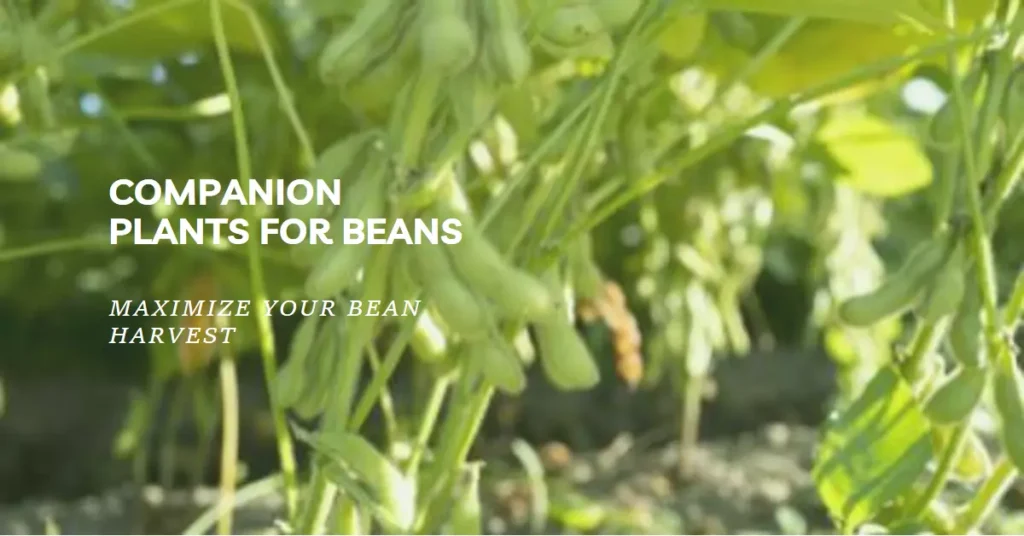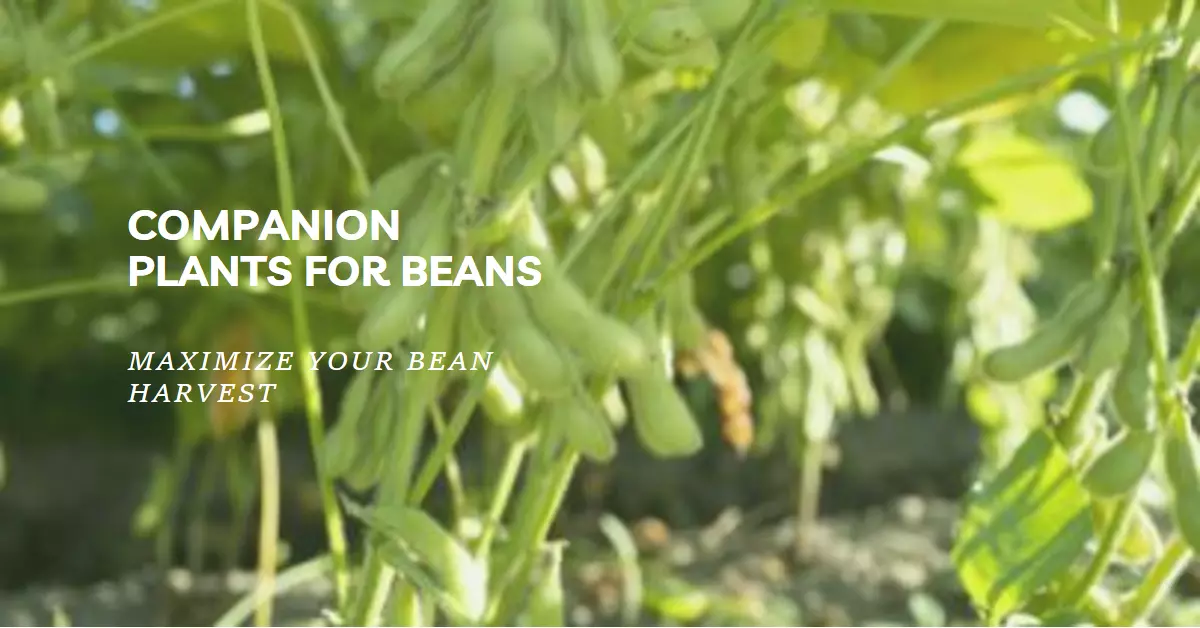Welcome to our blog post on companion plants for beans! If you’re a gardening enthusiast or simply looking to maximize the health and productivity of your bean plants, then this post is for you. Companion planting is a tried and tested technique that involves planting different species of plants together to benefit one another.
In this article, we will explore the benefits of companion planting for beans, the best companion plants to pair with beans, and plants that should be avoided. Plus, we will provide you with some tips on how to successfully implement companion planting in your garden. So, let’s dive in and discover how companion plants can enhance your bean growing experience!
Understanding the Basics: What is Companion Planting?
Companion planting is a gardening practice that involves growing different plants together to create a mutually beneficial relationship. It is based on the concept that certain plants can enhance the growth and health of others when planted in close proximity. This technique has been used for centuries by gardeners around the world to maximize yields, improve soil fertility, deter pests, and even enhance flavors.
The idea behind companion planting is that certain plants have natural traits that can benefit their neighboring plants. Some plants release specific chemicals into the soil that repel pests or inhibit the growth of harmful pathogens, while others attract beneficial insects that pollinate flowers or prey on garden pests. By strategically selecting companion plants, you can create a harmonious garden ecosystem that promotes plant health and increases overall productivity.
Companion planting is not limited to just vegetables; it can also involve incorporating herbs, flowers, and even trees into your garden layout. The key is to understand the specific needs and characteristics of each plant and how they can complement one another when grown together.
In the next sections, we will explore why beans specifically benefit from companion planting, the best companion plants to pair with beans, plants to avoid planting with beans, and essential tips for successfully implementing companion planting in your garden. So, let’s continue our journey into the world of companion plants for beans!
Why Beans Benefit from Companion Planting
Beans are a popular and versatile crop in many home gardens. They are not only delicious and nutritious, but they also offer several benefits when grown alongside companion plants. Let’s explore why beans benefit from companion planting:
1. Improving Soil Nutrition:
Companion plants can play a crucial role in improving soil nutrition for beans. Beans are known for their ability to fix nitrogen from the air and convert it into a form that plants can utilize. However, they require a sufficient supply of phosphorus and potassium for healthy growth and abundant yields. Certain companion plants, such as legumes and nitrogen-fixing plants like clover or vetch, can help replenish these nutrients in the soil, ensuring that beans have access to the necessary elements for optimal growth.
2. Disease and Pest Control:
Companion planting can also help in controlling diseases and pests that commonly affect beans. Some plants produce natural compounds that repel insects or inhibit the growth of specific pests and pathogens. By interplanting beans with these companion plants, you can create a natural barrier that deters pests and reduces the risk of disease outbreaks. For example, planting beans with marigolds can help repel aphids, nematodes, and bean beetles, while also attracting beneficial insects like ladybugs that prey on garden pests.
3. Maximizing Garden Space:
Another benefit of companion planting for beans is the efficient use of garden space. Beans are known for their vining habit, and they can climb up trellises or support structures. By planting companion plants that grow low to the ground, such as lettuce or radishes, alongside beans, you can make the most of vertical space while maximizing the productivity of your garden beds.
In the next sections, we will explore some of the best companion plants for beans, plants to avoid planting with beans, and essential tips for successfully implementing companion planting techniques in your garden. By harnessing the power of companion plants, you can enhance the health, vigor, and productivity of your bean plants while creating a thriving garden ecosystem. Let’s continue our exploration of companion plants for beans!

The Best Companion Plants for Beans
When it comes to companion planting for beans, selecting the right companion plants can make a significant difference in the health and productivity of your bean plants. Here are some of the best companion plants to pair with beans:
1. Corn:
Corn and beans have a long-standing companionship known as the “Three Sisters” planting method, which originated from Native American agriculture practices. Corn provides a natural trellis for beans to climb, while beans enrich the soil with nitrogen that benefits both crops. Additionally, the large leaves of corn help provide shade to the soil, reducing moisture loss and weed growth.
2. Cucumber:
Cucumbers and beans are compatible companions in the garden. Cucumbers have a sprawling growth habit that can help provide shade and moisture retention for the bean plants. In return, beans can help deter pests such as cucumber beetles. Be sure to provide trellising or support for both plants to maximize space utilization.
3. Marigolds:
Marigolds are excellent companion plants for beans due to their ability to repel pests. The strong scent of marigolds can deter aphids, nematodes, and bean beetles, which are common pests that can damage bean plants. Plant marigolds around the perimeter of your bean patch or intersperse them throughout the garden to provide natural pest control.
4. Potatoes:
Beans and potatoes complement each other well in the garden. While beans fix nitrogen in the soil, potatoes have a high demand for nitrogen. Planting beans near potatoes can provide a natural source of nitrogen for the potato plants, promoting healthy growth and higher yields for both crops. Be mindful of spacing to ensure that the taller bean plants do not shade the potato plants excessively.
5. Rosemary:
Rosemary is a beneficial herb that can enhance the growth of beans. Its strong aroma can deter pests like bean beetles and aphids. Planting rosemary near beans can also attract beneficial insects such as bees and hoverflies, which aid in pollination and pest control.
6. Summer Savory:
Summer savory is another herb that can be a great companion for beans. Its aromatic foliage can repel pests like bean beetles and aphids. Plant summer savory near your bean plants to provide natural protection against these pests.
These are just a few examples of the best companion plants for beans. Experimenting with different combinations and observing the interactions between plants can help you discover even more successful pairings in your garden. In the next section, we will discuss plants that should be avoided when planting beans to ensure the best growing conditions for your crop.
Plants to Avoid Planting with Beans
While companion planting can greatly benefit bean plants, it’s equally important to be aware of plants that may have negative effects when planted alongside beans. Here are some plants to avoid planting with beans:
1. Garlic and Onions:
Garlic and onions belong to the Allium family and are known to inhibit the growth of beans. They release compounds that can stunt the growth of beans and affect their overall productivity. It’s best to keep beans and Allium plants separate in the garden to avoid any potential negative interactions.
2. Sunflowers:
Although sunflowers are visually striking and attract beneficial pollinators, they can have a negative impact on nearby bean plants. Sunflowers produce a chemical called allelopathic compounds that can inhibit the growth of beans and other plants. If you plan to grow both sunflowers and beans, make sure to provide sufficient distance between them to prevent any negative effects.
3. Gladiolus:
Gladiolus is a beautiful flowering plant, but it can compete with beans for nutrients and space. The tall and dense growth of gladiolus can shade the bean plants, reducing their access to sunlight and hindering their growth. It’s advisable to keep gladiolus separate from your bean patch to ensure optimal growth for both plants.
By avoiding planting these incompatible plants with beans, you can prevent potential competition for resources and ensure that your bean plants have the best growing conditions possible. In the next section, we will provide you with essential tips on how to successfully implement companion planting techniques for beans in your garden. Stay tuned!
Also Read | Companion Plants for Beets
How to Successfully Implement Companion Planting
Implementing companion planting techniques for beans requires careful planning and consideration. Here are some essential tips to help you successfully incorporate companion planting into your garden:
1. Understanding Plant Spacing:
When planting companion plants with beans, it’s crucial to consider their mature size and growth habits. Ensure that you provide enough space between plants to avoid overcrowding, which can lead to competition for resources and hinder the growth of both plants. Follow recommended spacing guidelines for each plant variety to promote healthy growth and airflow.
2. Timing Your Planting:
Timing is crucial when it comes to companion planting. Consider the growth rates and harvest times of different plants to ensure compatibility. For example, if you’re interplanting beans and corn, make sure to plant the corn first since it takes longer to establish. This allows the corn to provide the necessary support for the bean vines as they grow.
3. Maintaining Your Garden:
Regular maintenance is essential for a successful companion planting garden. Monitor your plants for any signs of diseases or pests and take appropriate action promptly. Remove any weeds that may compete with your companion plants for resources. Water your plants regularly, providing adequate moisture without overwatering. Additionally, consider adding organic matter, such as compost or mulch, to improve soil fertility and retain moisture.
4. Observing and Adjusting:
Pay close attention to the interactions between your companion plants and make adjustments as needed. Observe how the plants are growing and if any negative interactions or competition are occurring. If certain companion plants are not working well together, consider making changes in the next growing season. Experimentation and observation will help you fine-tune your companion planting combinations over time.
5. Keeping Records:
Maintain a garden journal or record of your companion planting endeavors. Note which combinations worked well and which did not. Keep track of any observations, successes, and challenges you encounter. This record will serve as a valuable resource for future planning and provide a reference for optimizing your companion planting strategies.
By following these tips, you can successfully implement companion planting techniques for beans and create a harmonious garden environment that promotes healthy growth and abundant yields. Remember, companion planting is a dynamic process that may require some trial and error. Enjoy the journey of discovering the perfect companions for your beans and the benefits they bring to your garden. Happy gardening!
